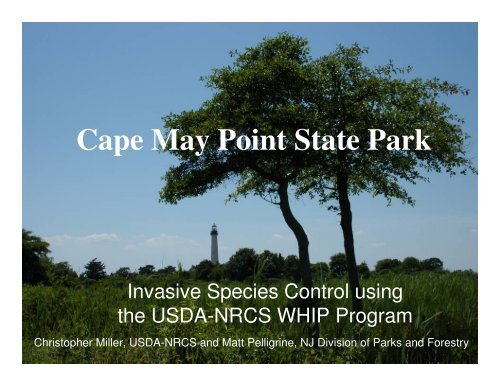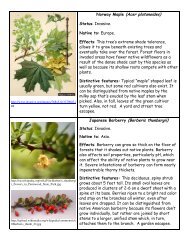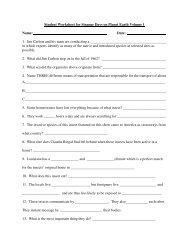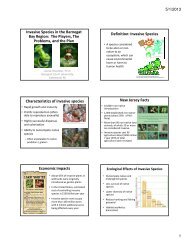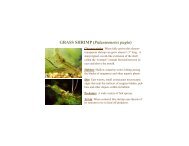posted here
posted here
posted here
You also want an ePaper? Increase the reach of your titles
YUMPU automatically turns print PDFs into web optimized ePapers that Google loves.
Cape May Point State Park<br />
Invasive Species Control using<br />
the USDA-NRCS WHIP Program<br />
Christopher Miller, USDA-NRCS and Matt Pelligrine, NJ Division of Parks and Forestry
Lower Cape May Meadows
How Many Vines Can you Spot
Maritime Forest-2004
Rationale for Invasive Species<br />
Control<br />
• Wooded and transitional areas of the park have<br />
become highly degraded by a mixture of<br />
invasive, non-native vines and shrubs.<br />
• These plants inhibit succession of desirable<br />
species and render the trees of the park more<br />
susceptible to blow down from storms.<br />
• If not addressed, the Park will lose most of it’s<br />
maritime forest in the next few years, reducing<br />
vital habitat for migrating birds and native<br />
wildlife.
Restoration Plan Summary<br />
• Treat 20 acres of the 44 acres of forest<br />
over a period of 5 years. (2004-2008)<br />
• Years 1-2: Cut vines in May shortly after<br />
leaf-out (little root reserves left)<br />
• Years 1-2: Chemical control in late<br />
September-October<br />
• Year 3:Begin restoration planting (2006)<br />
• Years 4-5:Continue maintenance/planting<br />
– Most work done by seasonal/volunteer staff.
Target Invasive Species<br />
• Virgin’s Bower Clematis<br />
(Clematis flammula)*<br />
excudes a noxious gas<br />
when cut that burns the<br />
eyes.<br />
• Climbs trees extremely<br />
quickly<br />
• Mowing alone not very<br />
effective<br />
• Takes approx. 3 weeks to<br />
show injury from chemical<br />
application
Target Invasive Species<br />
• Porcelainberry<br />
(Ampelopsis<br />
brevipedunculata)<br />
• It is especially<br />
abundant in open<br />
thickets and sand<br />
dunes along coastal<br />
portions of NJ.<br />
• Repeated mowing<br />
effective for control
Target Invasive Species<br />
• Multiflora rose (Rosa<br />
multiflora)<br />
• In shadier<br />
environments it<br />
climbs toward the<br />
light.<br />
• Affected by Rosa<br />
rosette disease
Target Invasive Species<br />
• Japanese<br />
honeysuckle<br />
(Lonicera japonica)<br />
• One of the first<br />
species to leaf out in<br />
the early Spring.<br />
• Produces<br />
considerable above<br />
AND below ground<br />
biomass
Native Vines<br />
• Greenbriar (Smilax rotundafolia)<br />
• Virginia creeper (Parthenocissus<br />
quinquefolia)<br />
• Poison Ivy (Toxicondendron radicans)<br />
• Fox grape (Vitis labrusca)<br />
• Trumpet creeper (Campis radicans)
The Wildlife Habitat Incentives<br />
Program and Invasive Exotics<br />
“WHIPing Your Land into Shape”<br />
USDA-Natural Resources Conservation<br />
Service
Wildlife Habitat Incentives Program<br />
• Develop, Improve, and Maintain Wildlife Habitat<br />
• Non-federal Land<br />
• Up to 75% Cost Sharing Available<br />
• 5-10 Year Agreements<br />
• NRCS/Landowner Conservation Plan<br />
• Competitive (Projects ranked on environmental<br />
benefits)
WHIP Priorities in NJ (2004-2007)<br />
• Early Successional Habitat<br />
• Riparian Habitat<br />
• Federally Threatened Bog Turtle<br />
• Habitat at Schools/Envirn. Ed. Areas<br />
• Invasive Exotic Vegetation Control<br />
• Lower Cape May Meadows ecosystem
www.nj.nrcs.usda.gov
With A lot of Perseverance<br />
Before Treatment<br />
After Restoration
Why the Plantation like Planting<br />
…..to assist with mechanical weed control
Restoration Species Planted<br />
• Pitch Pine (Pinus rigida)<br />
• Loblolly Pine (Pinus taeda)<br />
• Sweetgum (Liquidambar styraciflua)<br />
• Red Maple (Acer rubrum)<br />
• Southern Red Oak (Quercus falcata)<br />
• Chestnut oak (Quercus prinus)<br />
• Black oak (Quercus velutina)<br />
• Willow Oak (Quercus phellos)<br />
• Sassafras (Sassafras albidum)<br />
• Persimmon (Diospyros virginiana)<br />
• Black cherry (Prunus serotina)<br />
• Black gum (Nyssa sylvatica)
Restoration Species-Local Sources<br />
Difficult to Obtain<br />
• Post oak (Quercus stellata)<br />
• American Holly (Ilex opaca)<br />
• Eastern Red Cedar (Juniperus virginiana)
And these guys don’t help either
Early Spring-2008
Summer 2009
Summary<br />
• Invasives were controlled fairly well in highly<br />
visible target areas of the park (trails, overlooks,<br />
etc.) REQUIRES repeated mowing/chemical<br />
treatment.<br />
• Need a consistent workforce dedicated solely to<br />
invasive species control and retreatment.<br />
• Contracting out the work would have been more<br />
costly, but probably beneficial for long term<br />
control.


